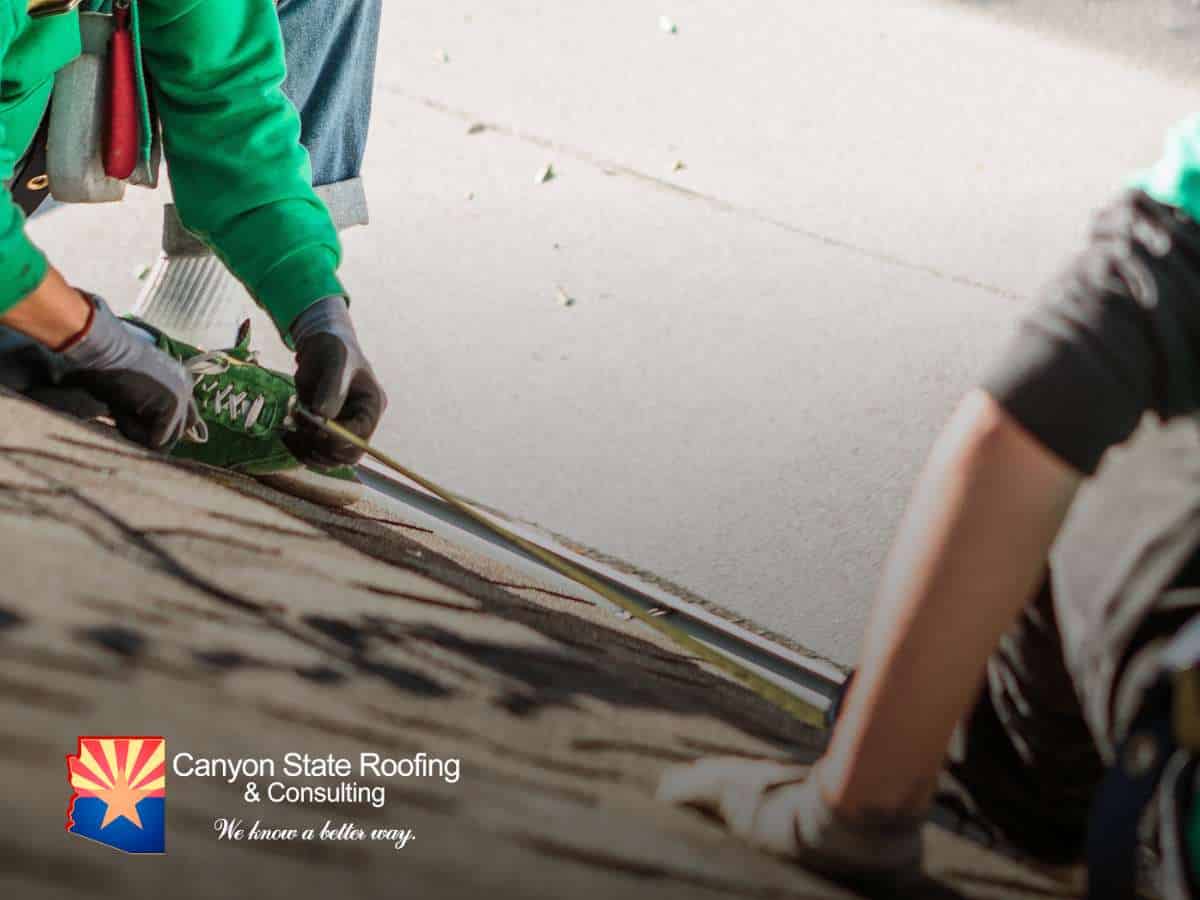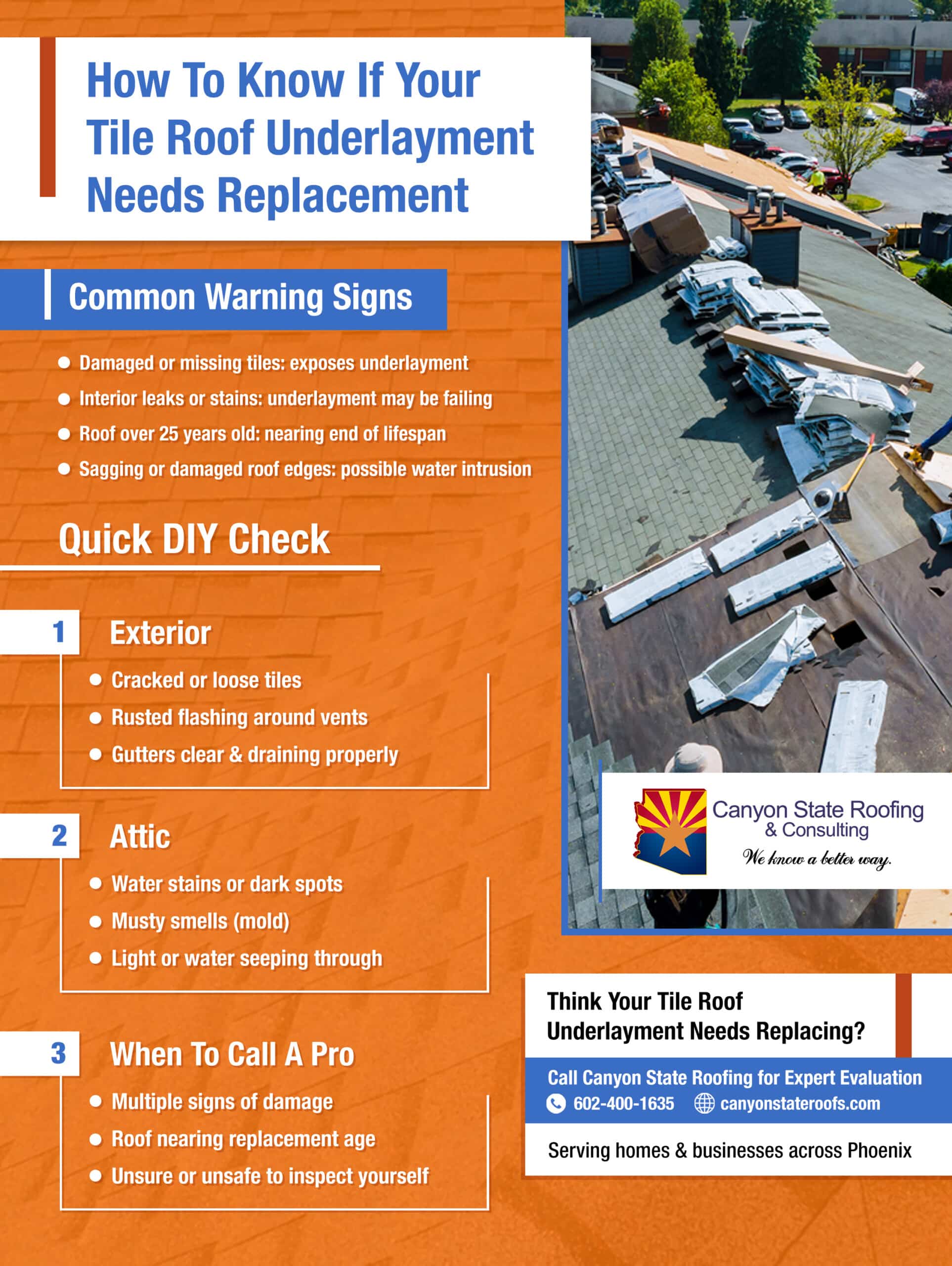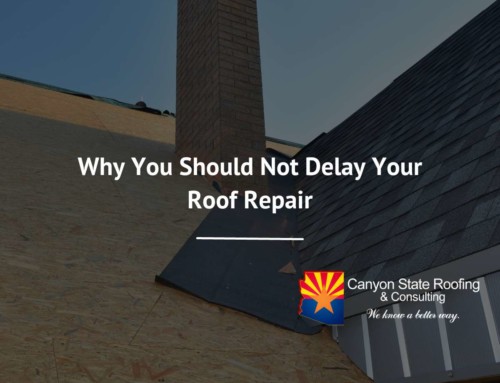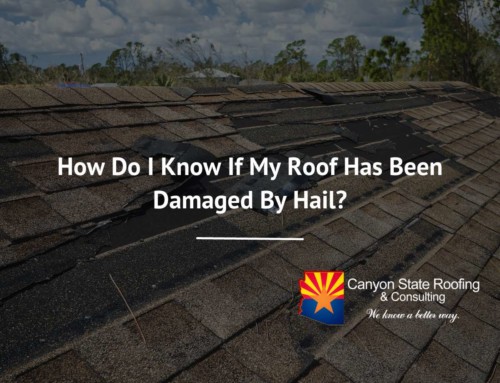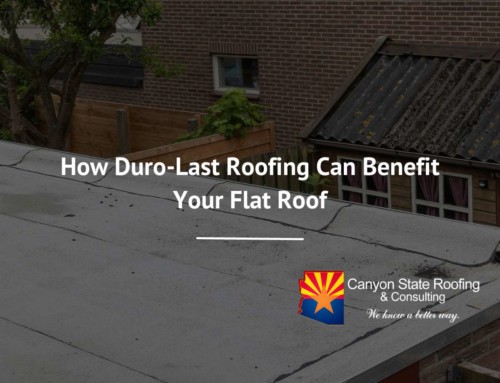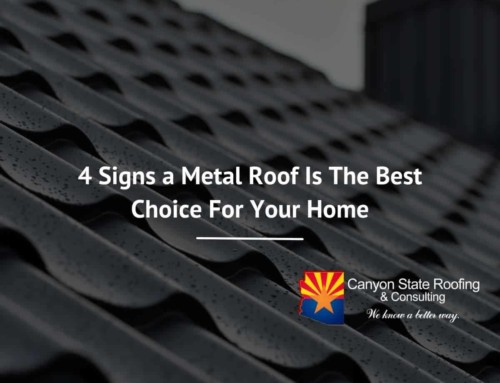Table Of Contents
- Beware Of These Common Signs Of Tile Roof Underlayment Damage
- What Is Roofing Underlayment?
- Some Roofing Tiles Are Missing Or Damaged
- You See Water Damage Inside Your Home
- Your Underlayment Is Getting Old
- Your Soffits, Fascia, or Gutters Have Become Damaged
- How To Check Your Underlayment
- When DIY Is Safe vs. When To Call A Professional
- FAQs:
- Professional Roof Assessment From Top-Rated Phoenix Roofing Contractors
How Do I Know If I Need To Replace My Tile Roof Underlayment?
Beware Of These Common Signs Of Tile Roof Underlayment Damage
Across the Valley, tile roofs are a popular option for homes and businesses. Their natural look and coloring offer boosted curb appeal and attractive aesthetic for almost any southern style home while also providing extra protection from the typical hot and dry weather patterns across Arizona.
But did you know that your home’s tile roof is actually made up on several layers that work together to create an effective roofing system? One of the most underappreciated and unknown, but crucially important, elements of a tile roofing system is the underlayment.
If you notice leaks, loose tiles, or your roof is over 20 years old, it may be time to replace its underlayment to avoid worse damage in the short term. Keep reading below to see other signs and keep your roof performing like new.
What Is Roofing Underlayment?
Roofing underlayment is a water-resistant material that is unrolled and installed over the roof deck of your home. The tiles are then installed by Ahwatukee’s new roof installation over the top of the underlayment layer.
Underlayment is crucial to your roof because it adds a layer of protection from the elements to help keep water and moisture out of your home. Its water resistance can help prevent mold growth in your attic or the roof deck.
Arizona’s intense sunshine, high temperatures, and occasional monsoons take a toll on all parts of tile roofs, including the underlayment. Although tile roofs are known for their durability and longevity, many homeowners don’t realize that the underlayment layer will probably need to be replaced by Anthem roof repair long before the tiles reach the end of their lifespan.
If you’re wondering how you will know that your tile roof’s underlayment needs to be replaced, consider these signs:
Some Roofing Tiles Are Missing Or Damaged
Every time the tiles on your roof are missing or undergo physical damage, your roof’s underlayment is at risk, too. These damages are usually caused due to storms, fallen tree branches, pests, and other causes.
The longer your roof’s underlayment is exposed to the elements without the protection of the tiles over the top, the more likely it is that the underlayment will become damaged and need to be replaced. Missing tiles leave your home vulnerable to mold, water damage, and pest infestations such as termites, all of which can weaken the structure of your home and cause major –and expensive– problems.
If your home has missing or damaged tiles, schedule a service appointment with Fountain Hills roofing contractors right away so that the damage can be assessed and repaired before it gets worse.
You See Water Damage Inside Your Home
No one wants to see water circles, dripping, or other signs of water leaking inside their home, but this is a common result of different types of damage to your home, including malfunctioning underlayment.
Because underlayment is designed to be resistant to water, it helps keep water out of your home, but exposure or simply reaching the end of its lifespan means that it can no longer do its job of keeping water out of your home. This can cause water circles and other signs of water damage inside your home. Call your Gilbert roofing company to examine your roof and provide the best solution.
Your Underlayment Is Getting Old
Tile roofs can be expected to last for at least 50 years with good maintenance and ideal weather conditions, but underlayment typically wears around between 25 and 30 years. If you’ve never had your roof replaced or examined by Glendale tile roofing, it might be a good time to have it inspected.
Your contractor can estimate the age of the underlayment if you’re not sure when the roof was last replaced. Although age is not usually the only reason to replace underlayment, it’s something to take into consideration if other issues with your roof or home need attention.
Your Soffits, Fascia, or Gutters Have Become Damaged
When water can’t be drained properly off of your roof, it can back up and result in waterlogged, damaged underlayment. The excess water around the edges of your can cause the roof deck to rot, meaning the roof deck and the underlayment will need to be replaced even if the roof tiles are still in great condition.
If you’ve noticed damage to your soffits, fascia, or gutters, contact Peoria Residential Roofing to inspect and verify whether your underlayment is still in good condition.
How To Check Your Underlayment
The best way to identify early warning signs of underlayment failure or tile roof underlayment wear is through regular roof maintenance inspections. Here’s how you can examine both the outside and inside of your roof safely and effectively.
- Exterior inspections: Start the inspection by walking around your home and visually checking the roof from ground level. Look for cracked, slipped, or missing tiles. Check for sagging areas, water stains along the eaves, and debris buildup in valleys or gutters, which can trap moisture.
Avoid climbing on the roof yourself. Visual inspections from the ground or a stable ladder are safest. If you’re unsure, it’s best to call a professional roofer.
- Interior (Attic) inspections: Your attic can also reveal what’s happening beneath the tiles. On a bright day, turn off the attic lights and look for sunlight peeking through the roof boards. Also, inspect for damp insulation, dark water stains, mold growth, or a musty odor, all of which indicate moisture intrusion.
In Arizona’s heat, underlayment tends to dry out and deteriorate faster beneath tile roofs—especially on older homes.
When DIY Is Safe vs. When To Call A Professional
While simple visual checks from the ground or inside the attic are generally safe, other things can be quite dangerous for any homeowner.
- DIY is safe when performing visual inspections from the ground or inside your attic. It’s also safe when looking for missing tiles, visible sunlight through the roof boards, or checking signs of moisture like stains or mold. These quick observations can help you spot potential underlayment issues early without risking injury.
- Call a professional when suspecting damage that goes beyond your limits. You should avoid climbing onto the roof or moving tiles yourself. Tile surfaces are slippery and fragile, and one wrong step can cause breakage or accidents. A licensed roofing professional has the right tools and training to safely assess the underlayment, detect hidden damage, and recommend proper repairs or replacement.
FAQs:
- How Often Should Underlayment Be Replaced?
Tile roof underlayment typically lasts 20 to 30 years, depending on material quality and weather conditions. Due to Arizona’s hot, dry climate, UV exposure can shorten its lifespan, so it’s wise to schedule professional inspections every few years once your roof reaches the 15-year mark. - Can Damaged Underlayment Cause Leaks?
Yes, of course! The underlayment is your roof’s main barrier against water. When it cracks, tears, or deteriorates, rainwater can seep through, leading to leaks, wood rot, and interior water damage. - Is It Possible To Replace Underlayment Without Removing Tiles?
Generally, no. To access and properly replace the underlayment, roof tiles must be temporarily removed and then reinstalled. This allows roofers to inspect the decking and ensure the new material is correctly sealed and secured. - How Much Does It Cost To Replace A Roof Underlayment?
The cost of replacing roof underlayment varies based on factors such as roof size, slope, tile type, and labor requirements. Prices can differ widely across Arizona, so it’s best to request an on-site inspection and quote from a licensed roofing professional for an accurate estimate. Contact our team today at 602-400-1635 to schedule an inspection and get a personalized quote for your roof underlayment replacement.
Professional Roof Assessment From Top-Rated Phoenix Roofing Contractors
If you’ve noticed any signs that your underlayment needs replacement, call Canyon State Roofing at 602-400-1635 to schedule a service appointment. We can offer an honest assessment based on our many years of experience in the roofing industry and will give you a free estimate on the cost of any needed repairs, so you can enjoy peace of mind knowing that your roof is protecting your home the way it should be. Contact our trusted team of roofers today!
Canyon State Roofing
4809 E Thistle Landing Dr #100
Phoenix, AZ 85044
Office: 602-400-1635
Email: [email protected]
Website: www.canyonstateroofs.com


